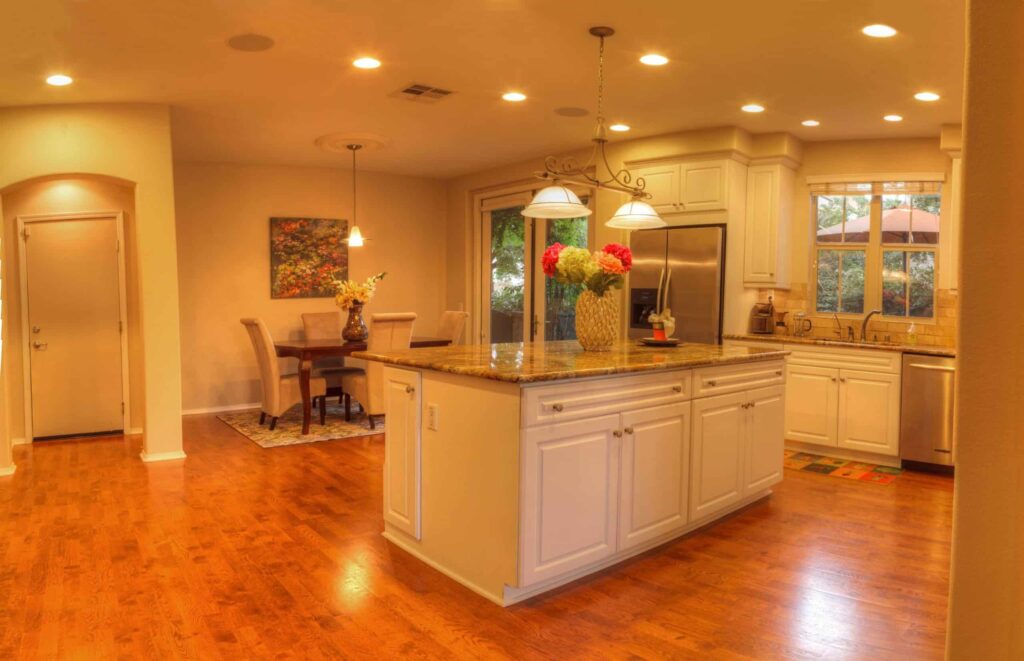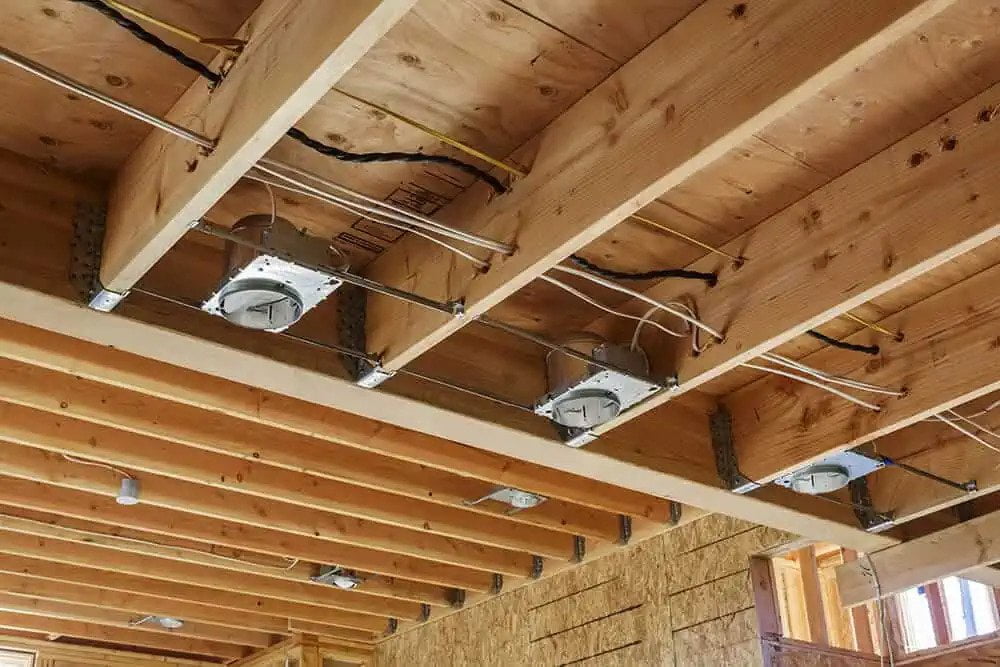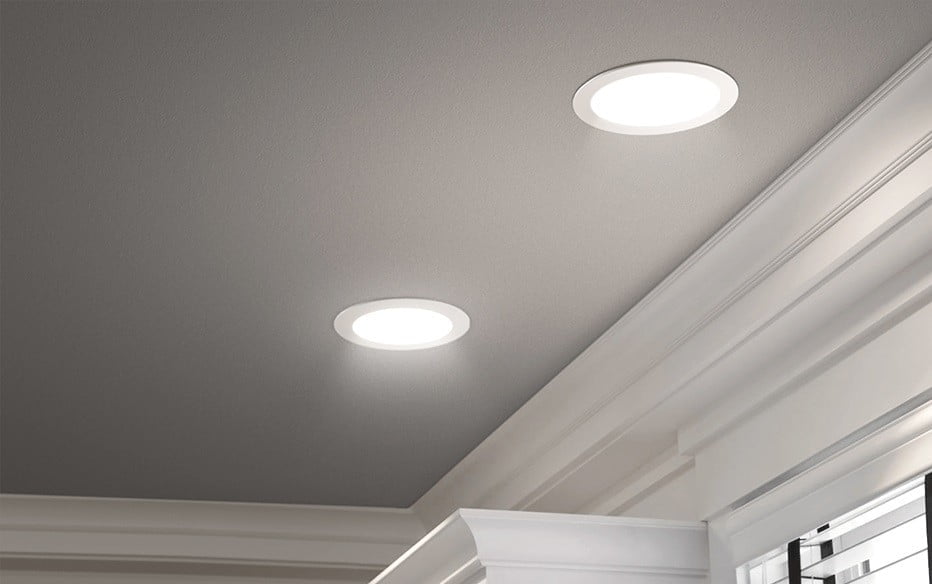IC-Rated Vs Non-IC Rated Recessed Lighting Fixtures
Table of Contents
Recessed lights are fixtures that are installed directly into the ceiling or surface. There are two types of recessed lights: IC-rated and non-IC-rated. But what do these ratings mean, and how do they differ?
IC and non-IC ratings determine whether a fixture can be used on an insulated surface. IC-rated recessed lights are suitable for insulated ceilings. They are airtight, cost-effective, and easy to install. On the other hand, non-IC-rated recessed lights are not suitable for insulated surfaces. They have holes that can transfer heat directly to the insulator, leading to fire hazards. However, they can be used on uninsulated walls.
This article will explore the differences between IC and non-IC-rated recessed lights, their usage, and how to choose the best option for your apartment.

What is an IC-Rated Recessed Light?
IC rating stands for Insulation Contact. It refers to the capability of a light fixture to have direct contact with insulation. IC-rated recessed lights can come in contact with insulation without any fire hazards. They have a 75 to 100 watts range and feature an advanced thermal protection system to prevent overheating. This makes them safe to use with insulation materials like cellulose.
Most houses nowadays have insulation in the ceiling and walls to regulate temperature. However, installing non-IC-rated recessed lights in an insulated ceiling can be hazardous due to the heat they generate. Halogen lights, for example, can reach high temperatures that pose a danger when used near combustible materials. IC-rated recessed lights mitigate these risks by automatically turning off when they overheat, ensuring safety and preventing fire outbreaks.
| Pros | Cons |
| Suitable for both insulated and uninsulated surfaces energy-efficient automated thermal protection doesn’t d’ get overheated easy installation airtight/doesn’t have holes safe/any fire hazards | Limited-wattage fixtures are expensive |
What is a Non-IC Rated Recessed Light?
Non-IC-rated recessed lights have a single can with ventilation holes. They lack a proper thermal protection system, making them prone to overheating. As a result, they are not suitable for use on insulated surfaces.
These recessed lights work well in areas where insulation is not required. They can dissipate heat quickly into the surrounding air. However, when installed on an insulated surface, they pose a high risk of fire hazards. Additionally, they can affect the durability of the light and cause discoloration on the ceiling.
| Pros | Cons |
| Suitable for uninsulated surfaces affordable allows high wattages supports higher lumen ratings | Not ideal for insulated surfaces easily gets overheated automated thermal protection is available more energy has fire hazards. |

How IC and Non-IC Rated Recessed Lights Work
The working mechanisms of IC and non-IC-rated recessed lights differ significantly. IC-rated lights have a double-can structure called “Can within Can,” with insulation between the two cans. This insulation layer helps keep the outer can cooler when the inner can get hot. As a result, IC-rated lights can be installed directly in insulation without the risk of combustion.
In contrast, non-IC-rated recessed lights have a single can with ventilation holes. These holes allow heat to dissipate into the surrounding space. When installed on an insulated surface, these lights transfer heat directly to flammable materials, increasing the risk of fire outbreaks. To mitigate this risk, non-IC-rated lights should be placed at least 3 inches below insulated ceilings and require a covering around the fixture.
How to Identify IC vs. Non-IC Rated Recessed Lights
To determine whether your recessed lights are IC or non-IC-rated, follow these steps:
Examine the Light Fixture: Trim around the fixture and remove the lightbulb to inspect the inner section of the recessed light using a flashlight.
Read the Label: Look for a label inside the light fixture. IC-rated recessed lights usually have an ‘IC’ marking with a label number, while non-IC-rated lights have a ‘NON-IC’ label. The label may also indicate the wattage of the bulb. If there are no markings, there are alternative methods to identify them.
Holes & Slit Inspection: Check for any holes or slits in the recessed lights. If present, they are non-IC-rated fixtures. These lights have no thermal protection system and dissipate heat through these openings. Non-IC-rated lights are unsuitable for installation in insulated ceilings. If no holes or slits are found, consider them IC-rated fixtures, which have no air leakage and can be used on insulated surfaces.
Color Check: IC-rated recessed lights are usually silver, while non-IC-rated lights are white. However, relying solely on color is not a foolproof identification method. If in doubt, consult a professional. If the lights are non-IC rated, replace them with IC-rated ones immediately.
| IC-Rated | Non-IC Rate |
| Silver | White |
Lighting Check: Observing the lighting is another way to determine the rating. Turn on the recessed lights and see if light emits from the ventilation holes. If it does, they are non-IC rated. If there is no light emission, the lights are airtight and IC-rated.

Comparison Chart – IC vs. Non-IC Rated Recessed Light Fixtures
| IC Rated Recessed Light | Non-IC Rated Recessed Light |
| IC-rated recessed lights are suitable for installation on insulated surfaces. | Non-IC-rated recessed lights are not ideal for insulated surfaces. |
| IC-rated recessed lighting has a double-can structure. | Non-IC-rated lights have a single-can structure with holes. |
| The IC-rated recessed lights have a limited wattage, ranging from 75 to 100 watts. | The recessed lights with no IC rating can have wattage as high as 150 watts. |
| These lights don’t have holes or slits. | They have holes or slits for heat dissipation. |
| You can install them in attic ceilings without keeping any gaps. | There must be at least 3 inches between the ceiling and the non-IC-rated light fixture. |
| These lights don’t create condensation buildup problems as they are airtight. | Non-rated recessed lights are not airtight so they can create moisture condensation buildup issues. |
| IC-rated fixtures have an automated thermal protection system. | No automated thermal protection system is available for non-IC-rated recessed lights. |
| These lights are energy-efficient. | They use more energy. |
| The color of the IC-rated recessed light is silver. | The non-IC-rated recessed lights are white. |
| These types of recessed lights produce minimal heat while operating. | Recessed lights without IC ratings easily get overheated. |
| IC-rated recessed lights are safer as they have no fire-hazardous issues. | Insulators are highly flammable, so when non-IC-rated recessed lights are installed, they can cause fire breakouts. |
| Brighter or stronger light bulbs are not allowed for IC ratings as they can get overheated. However, LED lights are suitable for IC-rated recessed lights. | Non-IC-rated recessed lights support high-powered bulbs with higher lumen ratings. |
| The system shuts off the lighting when the IC-rated recessed lights start overheating. | The non-IC-rated recessed lights don’t get shut off when overheated. They instead disperse heat to the surrounding air through holes in them. In case there are any obstacles, it causes fire to break out. |
Here are the differences between IC and non-IC-rated recessed lights:
- Usage: IC-rated recessed lights can be used in insulated and uninsulated ceilings. They have an automated thermal protection system and a limited wattage range to prevent overheating. Non-IC-rated lights are unsuitable for cellulose-insulated ceilings as they quickly overheat, posing fire risks. They are recommended for uninsulated surfaces.
- Construction: Non-IC-rated lights have holes and slits for heat dissipation, while IC-rated lights are airtight with no gaps or slits.
- Wattage: IC-rated lights use lower-wattage bulbs, while non-IC-rated lights can support both high and low-wattage bulbs, making them compatible with brighter bulbs and higher lumen ratings.
- Price: IC-rated recessed lights are typically more expensive than non-IC-rated lights due to their advanced features and better safety measures.
Which Recessed Lighting Is Better: IC vs. Non-IC Rated?
When deciding between IC and non-IC-rated recessed lights, consider the following factors:
- Geographical Location: IC-rated lights are ideal for houses with insulation systems in cold countries to prevent heat loss. Non-IC-rated lights are suitable for regions with moderate climates or without insulation.
- Thermal Protection: IC-rated lights have an automated thermal protection system that turns off when overheating occurs. Non-IC-rated lights lack this system, making them prone to overheating and fire hazards.
- Safety and Affordability: Non-IC-rated lights have a higher risk of fire outbreaks than IC-rated ones. IC-rated lights prioritize safety but are more expensive due to their advanced features.
- Compatibility with Brighter Light Bulbs: Non-IC-rated lights can support higher-wattage bulbs and provide brighter illumination, while IC-rated lights have a wattage limitation.
- Easy Installation and Energy Efficiency: IC-rated lights are easier to install, consume less energy, and save electricity. Non-IC-rated lights require removing insulation and take more effort to install, leading to increased energy consumption.
Considering all these factors, IC-rated recessed lights are generally better for insulated and uninsulated houses. They offer safety, energy efficiency, and lower maintenance costs. However, non-IC-rated lights are more affordable and compatible with higher-wattage bulbs, making them suitable for uninsulated homes with budget constraints.
Can You Use Non-IC Rated Recessed Lights in an Insulated Ceiling?
While non-IC-rated recessed lights are unsuitable for insulated ceilings due to the heat dissipation holes, there is a way to use them safely with insulation. You can use an airtight cover to prevent the fixture from contacting the insulator. Ready-made covers are available, or you can create a DIY cover using fire-rated materials like rigid foam insulation. Additionally, ensure a minimum of 3 inches of space between the light’s metal housing and any other object.

Advantages of Recessed Lighting
Recessed lighting offers several benefits, including:
- Space Illusion: Recessed lights can create an illusion of space, making small rooms appear larger. They work well in narrow areas like hallways.
- Accent Lighting: Recessed lights can be used for accent lighting to highlight textures or artwork on walls.
- Even Lighting: Multiple recessed lights provide equal lighting in all corners, eliminating direct glare. The fixtures remain hidden in the ceiling, creating a clean, discreet look.
- Lightweight: Recessed lights are lightweight and small, making them easy to attach directly to drywall.
Drawbacks of Recessed Lighting
Recessed lighting also has some drawbacks to consider:
- High Cost: Installing multiple recessed lights can significantly increase the cost compared to traditional lighting fixtures, as you need several units for adequate lighting.
- Permanent Fixture: Once installed, recessed lights cannot be easily changed, limiting flexibility in adjusting lighting designs.
- Complex Installation: Installing recessed lights involves creating multiple holes in the ceiling, which requires professional assistance. Insulated walls add further complexity to the installation process.
- Safety Concerns (Non-IC Rated Lights): Non-IC-rated recessed lights pose a high risk of fire outbreaks when used in insulated ceilings.
Final Thought
The key distinction between IC and non-IC-rated recessed lighting lies in their usage. IC-rated fixtures can be used in insulated surfaces, whereas non-IC-rated fixtures cannot. Furthermore, they differ in terms of their construction and brightness.
IC-rated fixtures excel in both safety and energy efficiency, as they are designed to eliminate fire hazards and save on electricity bills. On the other hand, non-IC-rated recessed lights are suitable exclusively for uninsulated surfaces.
MyLikeLed specializes in manufacturing top-notch LED strips and LED neon flex. Our products undergo rigorous testing in state-of-the-art laboratories to guarantee the highest quality standards. Moreover, we offer customization options for our LED strips and neon flex. For the premium LED strip and LED neon flex solutions, don’t hesitate to contact MyLikeLed immediately!
FAQs
You need an IC-rated light if your ceiling has insulation. If there’s no insulation around the fixture, a non-IC rated option can be used safely.
Yes, you can replace a non-IC rated fixture with an IC-rated one. In fact, upgrading can improve safety, especially if insulation might come into contact with the fixture.
If you use a non-IC rated light near insulation, it can overheat and create a serious fire risk. Always choose an IC-rated fixture in insulated spaces.
Yes, IC-rated fixtures are often more energy-efficient. Since they are sealed to work safely with insulation, they help maintain better temperature control and reduce energy loss.
Yes, IC-rated fixtures are usually a bit more expensive. However, the extra cost is worth it for the added safety and energy savings over time.

Hi, I’m Xylia Xiong, a sales professional with 14 years of experience in the LED strip light industry. I specialize in providing tailored solutions, leveraging my expertise in LED products and the latest industry trends. Known for effective communication and problem-solving, I’m dedicated to helping lighting manufacturers, importers, and distributors achieve their goals.
Let’s work together to create customized solutions that exceed expectations.
Related Posts

The Best LED Strip Lights You Can Buy Right Now

Comparing WS2811 Vs WS2812B: Key Differences


